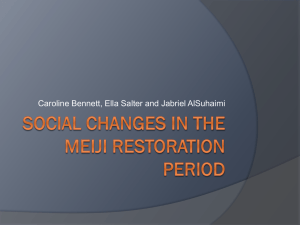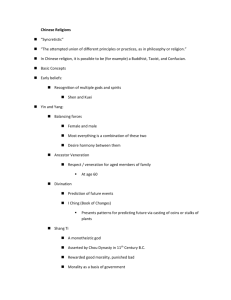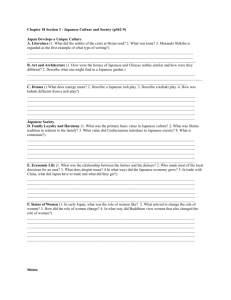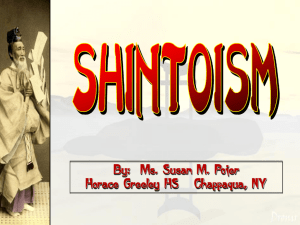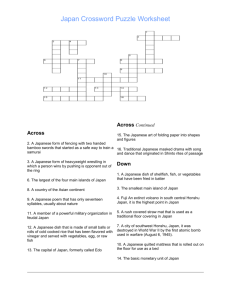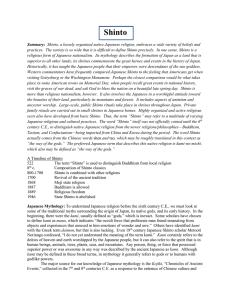Japan - BYU Marriott School
advertisement
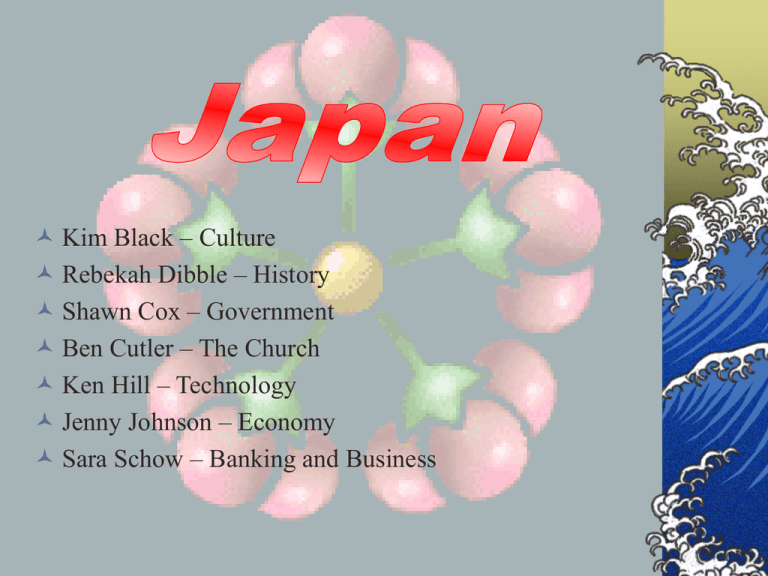
Kim Black – Culture Rebekah Dibble – History Shawn Cox – Government Ben Cutler – The Church Ken Hill – Technology Jenny Johnson – Economy Sara Schow – Banking and Business Map of Japan Regional Differences & Diversity Speed Train Oyster Farms Rice Fields Tokyo Population Comparisons 1,400 1,250 1,200 1,000 Thailand Japan China Hong Kong Singapore 800 600 400 200 61 126 7 0 Population in Millions 4 Customs & Etiquette Remove shoes, two kinds of slippers No tipping Restrooms, B.Y.O.T.P. Importance of gifts, often food Slurping, chopsticks, and other dining advice Religion 1% 5% 43% 51% Shinto Buddism Christian Other Shinto Shinto (the way of the gods) Shinto does not have a founder nor does it have sacred scriptures like the sutras or the bible The kami are the objects of worship in Shinto. They are sacred spirits and can take various forms such as natural elements like the sun, mountains, trees, rocks, and the wind. Shinto In contrast to Western religions there are no absolutes in Shinto, even though there is a most important goddess, the Sun goddess. A written code of ethics and morals does not really exist in Shinto; but the Confucian ethics had melted together with Shinto over the centuries. Nowadays, the people seek support from Shinto and visit shrines in order to pray for good fortune and to avoid evil spirits Buddhism Originated in India in the 6th century BC. Buddhism consists of the teachings of the Buddha, Gautama Siddhartha. Its central theories are that human life is full of suffering due to worldly desires, illness, death and the loss of loved ones. By getting rid of desires and attachments, one can achieve the state of enlightenment (Nirvana) and escape suffering and the circle of reincarnations. Buddhism Buddhism was imported to Japan in 538 or 552 in form of a present from the king of the friendly Korean kingdom of Kudara (or Paikche). The new religion was welcomed by the ruling nobles while the common people did not understand its complex theories. Nowadays about 90 million people consider themselves Buddhists in Japan. History of Japan Feudal Centuries-Five Main Periods Kamakura Period (1185-1333) Muromachi Period (1333-1576) Momoyama Period (1576-1600) Christian Century (1543-1640) Tokugawa Period (1600-1867) History of Japan (cont’d) Modern History and It’s Applications to Business Emperor Meiji-Westernization and Industrialization (1867) WWII Recovery Program and Success of the Japanese Economy Economic Stagnation, Corruption, the Asia Crisis History of Japan (cont’d) Japan Today Economy Rumors that Japanese Prime Minster is about to Resign Government Constitutional Monarchy 3 Branches of Power LDP (Liberal Democratic Party) is the main political party Emperor became only "symbol of the state” by the Constitution of 1946 Three Branches Cabinet (Executive): Prime Minister & cabinet Diet (Legislative): House of Representatives (500 members) House of Councillors (252 members) (Members elected by the people) Judiciary: Supreme Court and lower courts Prime Minister YOSHIRO MORI AGE: 62 PARTY: LDP FACTION: Fukuda DISTRICT: Lower House UNIVERSITY: Waseda Japan is "a divine nation with the emperor at its center" Establishing the Church On September, 1, 1901, Heber J. Grant (then a member of the Quorum of Twelve, and newly called president of the Japanese Mission) led his three companions to a secluded spot in a small grove situated on the slope of one of the rolling hills lying south of Yokohama, to dedicate the land of Japan to the preaching of the gospel. Translating the Book of Mormon On January 11, 1904, President Ensign asked all of the missionaries to begin translating different sections of the Book of Mormon. By September 15, they had completed the First Book of Nephi — forty-nine English pages. The first translation of the Book of Mormon was completed on March 21, 1906, but the corrections and revisions took longer than the original work. Because he was dissatisfied with his early sections, Taylor revised the entire first translation, and this took from May 1906 until December. The finished product was off the press on October 6, 1909. Five thousand copies were printed. The Church During WWII In 1924 the Japanese Mission was closed after a twenty-three-year history. On January 1, 1946, Emperor Hirohito issued a proclamation that he was not a divine or quasi-divine person and that the Japanese people were not superior in any way to other races and peoples. In the spring of 1947, the First Presidency called Brother Edward L. Clissold to go to Japan to investigate the possibility of re-opening the mission, and was set apart as mission president on October 22, 1947. The Tokyo Temple On September 13, 1980, ribbons were cut for the temple open house. On September 15, the public phase of the open house began. 48,000 visitors visited the the ten-million-dollar edifice. The temple was dedicated on Monday Oct. 27, 1980. On June 11, 2000 President Hinkley dedicated the Fukuoka mini temple. The Church Today Since 1996, five new stakes have been created in Japan bringing the total number of stakes in Japan to 30. Missionary work in Japan continues to progress despite cultural and social hindrances Technology Transfer Immediately after World War II, technology transferred mainly from the US to Japan. Constitution Rebuilding of their economy Capitalism Diffusion of technology has since then reversed. Technology Transfer Toyota Manufacturing Technology JIT (Toyota System) mid-1970’s TQM – Deming Prize Originally a way to compete with US In 1956 Japan adopted Quality as its national slogan Pokemon Sony Playstion2 Japan’s Economy GDP -0.5% 3rd quarter +0.8% 4th quarter Business investment for 4th quarter 2000 posted its biggest gain in almost 4 years Net export: -0.3% in 4th quarter Debt projected to reach 666 trillion yen ($5.6 trillion) which is approximately 130% of GDP In February, S&P cut Japan’s debt rating from AAA to AA+ Japan’s Economy BOJ (Bank of Japan) set short-term borrowing rates to 0.15% from 0.25% BOJ made official statement on changing policy: targeting money supply instead of targeting interest rates. April 2: Japanese Yen falls to its lowest level in 2.5 years. Japanese Quarterly GNP 1990-2000 Current: 0.8% (4th quarter 2000) Japanese Unemployment 1980-2000 Current unemployment: 4.9% Real Estate Valuations 1990 National All Commercial Residential Industrial Tokyo All Commercial Residential Industrial 2001 % Change 100 100 100 100 72.30 54.20 85.30 87.50 -27.7% -45.8% -14.7% -12.5% 100 100 100 100 28.70 21.00 36.50 41.90 -71.3% -79.0% -63.5% -58.1% Japanese CPI Nikkei 225: Last seven months Nikkei 225: Two decades Japanese Banking System The United States has an estimated 8500 commercial banks – Japan has fewer than 100. Bank Consolidation Current State of Japanese Banking System Greetings Handshake Traditional bow Business Cards Introductions Say “How do you do?”, not “Hello” Use Last names, plus san Corporate titles and ranks are very important Entertaining Business entertaining is usually after business hours and rarely in the home Allow your host to order for you Chopstick etiquette Helpful Hints Nodding is very important Quiet, dignified and modest behavior is essential Proximity Sit erect with both feet on the floor Do not compliment Japanese publicly Conducting Business Be introduced through an intermediary Gift giving Take your time in getting acquainted Observe Japanese meeting protocol Be aware of communication differences Giri, mutual obligation



